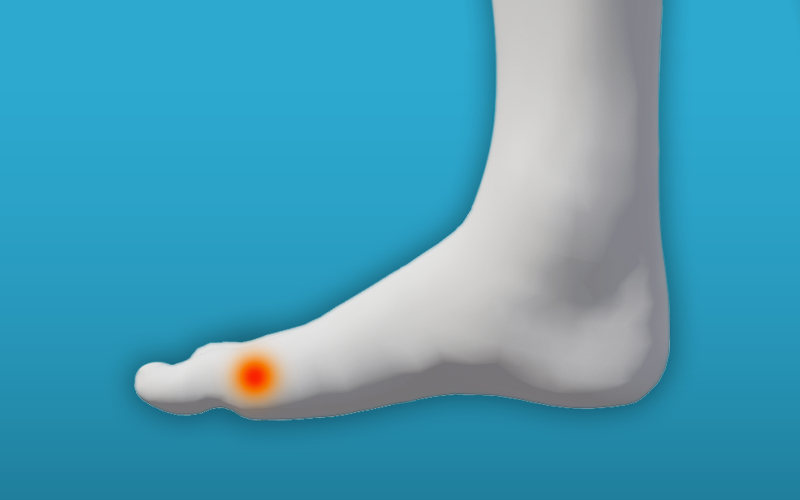
Bunions (Hallux Valgus)
What is it?
Bunions develop when the big toe (hallux) moves towards the second toe at an angle. It is also known as hallux valgus. The change in angle of the toe can be normal and it is not always a problem. However, bunions can sometimes be painful, for example, the change in position causes rubbing in the shoe. The big toe may deviate to the smaller toes and sometimes cross over or under them.
See below for some examples of a bunion
Hard lumps on the side of the big toe

The big toe pointing towards the smaller toes

Hard skin or callus may develop.

Sometime the change in position and rubbing on a shoe can cause hard skin or a callus. This become sore if rubbing in a shoe continues. There is also a small sac of fluid (bursa) that helps protect the joint, this can be become irritated and cause pain when there is pressure on the big toe.
There are other big toe conditions that can cause pain – please see Osteoarthritis (hallux rigidus) sections or Gout – please speak to your GP if you need further advice.
How to manage it
Orthoses/Insoles
As some bunions may be caused by collapse of the arches or flat feet, arch supports, also known as orthotics may help in some cases. Wearing corn plasters, pads or toe spacers may relieve local pressure
Here is an example of a medial arch support. These are widely available online and in a number of shops.
Foot orthotics with metatarsal pads may help redistribute and relieve pressure from the non-inflamed joints.
Please speak with a health care professional should you need any further advice.

Footwear
For bunions (hallux valgus), low heeled, wider fitting shoes with a rounded toe box and adequate height are essential to avoid any areas of pressure that may cause rubbing. Wearing high heeled shoes may worsen your symptoms.
For some big toe conditions such as osteoarthritis shoes with rocker sole modifications may also help. Rocker soles may be necessary to reduce motion at the joint which in turn reduce pain.
See the footwear section for further advice.
Simple painkillers
Painkillers like paracetamol will ease the pain, but need to be taken regularly in order to control the pain. Always follow the instructions on the packet.
Anti-inflammatories like ibuprofen can help with swelling, and therefore help you move more freely. Topical (applied directly on the affected body area) anti-inflammatories are recommended initially. Follow the instructions on the packet and discuss using them safely with a pharmacist, especially if you have any underlying health conditions
However, you should not take ibuprofen for 48 hours after an initial injury as it may slow down healing.
Up to date guidelines can be found on the NHS website:
Other medicines can help to reduce inflammation, swelling and pain. You should discuss this with your GP if the simple pain relief advice does not help or if you are needing to take ibuprofen for more than 10 days.
Ice Therapy
Some people find using ice on the hot, swollen area can help.
Use a damp cloth containing an icepack (or bag of frozen peas) on the painful area to help numb the pain. Apply it for up to 20 minutes, up to three times a day.
- People should be cautious using these treatments if they have altered skin sensation or circulatory problems.
- Check the skin regularly during and after the ice pack application
- Stop if there is excessive pain, numbness or tingling
- Do not put ice directly on to the skin as this may cause a burn.
Exercises
Regular stretching exercises for your calves will help to reduce the pressure on the front of your foot.
Stand in a walking position with the leg to be stretched straight behind you and the other leg bent in front of you. Take support from a wall or chair.
Lean your body forwards and down until you feel the stretching in the calf of the straight leg.
Hold approx. 30 secs. relax. Stretch the other leg. Repeat 3 times.

Stand in a walking position with the leg to be stretched behind you. Hold on to a support.
Bend the leg to be stretched and let the weight of your body stretch your calf without lifting the heel off the floor.
Hold approx. 30 secs. – relax. Repeat 3 times.

It is important to do both these exercises.
Usually a combination of improving your muscle flexibility and wearing orthotics in your shoes considerably reduces your pain.
Surgery and injections
If inflammation (synovitis) is present, injection of a local corticosteroid and anaesthetic may be useful. Surgery may be needed if things are not improving with self-management discussed.
If your symptoms are not manageable please discuss with your GP for further advice.
